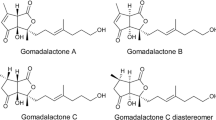Abstract
1,7-Dioxaspiro[5.5]undecane (olean), the major component of the female sex attractant pheromone blend of the olive fruit flyDacus oleae (Gmelin) was shown to be released as a racemate. The response of males and females to pure (R)-(−) and (S)-(+)-enantiomers was tested under laboratory and field conditions. Males in laboratory and field tests responded only to (R)-(−)-olean, which functions as a sex attractant. Females responded only to (S)-(+)-olean in laboratory tests but not in the field. There are indications that the latter enantiomer fuctions as a short-range arrestant throughout the day and as an aphrodisiac in the process of mating.
Similar content being viewed by others
References
Baker, R., Herbert, R., Howse, P.E., Jones, O.T., Francke, W., andReith, W. 1980. Identification and synthesis of the major sex pheromones of the olive fly (Dacus oleae).J. Chem. Soc. D. 1106:52–53.
Boland, W.,Ney, P.,Jaenicke, L., andGassmann, G. 1984. A closed loop stripping technique as a versatile tool for metabolic studies of volatiles, pp. 371–380,in Analysis of Volatiles. P. Schreier, (ed.).
Delrio, G.,Economopoulos, A.P.,Haniotakis, G., andProta, R. 1982. Comparative field studies on food, sex and visual attractants for the olive fruit fly. Proceedings International Symposium of CEC/IOBC on Fruit Flies of Economic Importance. Athens, Greece, November, 16–19, 1982, pp. 465–472.
DeMarzo, L., Nuzzaci, G., andSolinas, M. 1978. Studio anatomico, istologico, ultrastrutturale e fisiologico del retto ed osservazioni etologiche in relazione alla possibile produzione di feromoni sessuali nel maschio diDacus oleae Gmel.Entomologica 14:203–266.
Feron, M. 1959. Attraction chimique du male deCeratitis capitata pour la femelle.C.R. Acad. Sci. Paris 248:2403–2404.
Francke, W., Hermann, V., Gerken, B., Renwick, J.A.A., andVité, J.P. 1977. 2-Ethyl-1,6-dioxaspiro[4.4]nonane, principal aggregation pheromone ofPityogenes chalcographus (L.)Naturwissenschaften 64:590.
Grob, K., andZurcher, F. 1976. Stripping of trace organic substances from water; equipment and procedure.J. Chromatogr. 117:285–294.
Haniotakis, G.E. 1974. Sexual attraction in the olive fruit fly,Dacus oleae (Gmelin).Environ. Entomol. 3(1):82–86.
Haniotakis, G.E. 1979. Pheromone studies of the olive fruit fly,Dacus oleae (Gmel.). Final Report, NATO Reasearch Grant No. 1352, 69 pp.
Haniotakis, G.E. 1985. Attraction ofDacus oleae flies to food and sex attractants and their combinations.Entomol. Exp. Appl. In press.
Haniotakis, G.H., Mazomenos, B.E., andTumlinson, J.H. 1977. A sex attractant of the olive fruit fly,Dacus oleae, and its biological activity under laboratory and field conditions.Entomol. Exp. Appl. 21:81–87.
Haniotakis, G.E.,Kozyrakis, M., andHardakis, I. 1983. Applications of pheromones for the control of the olive fruit fly. Proceedings International Conference on Integrated Plant Protection. Budapest, Hungary, July 4–9, 1983. In press.
Mazomenos, B.E., andHaniotakis, G.E. 1981. A multicomponent female sex pher none ofDacus oleae (Gmelin). Isolation bioassay.J. Chem. Ecol. 7(2):137–144.
Mazomenos, B.E., andHaniotakis, G.E. 1984. Male olive fruit fly attraction to the synthetic sex pheromone components in laboratory and field tests.J. Chem Ecol. In press.
Mazomenos, B.E., andPomonis, G.J. 1983. Male olive fruit fly pheromone: Isolation, identification and lab biassays. Proceedings International Symposium of CBC/IOBC on Fruit Flies of Economic Importance. Athens, Greece, November 16–19, pp. 96–103.
Mazomenos, B.E.,Haniotakis, G.E.Tumlinson, J.H., andRagousis, N. 1981. Isolation, identification, synthesis and bioassays ofDacus oleae pheromones. Panhellenic Congress of Agricultural Research. Kallithea, Chalkidiki, Greece, May 5–6, 1981. Abstract pp. 96–97.
Mori, K., Urmatsu, T., Watanabe, H., Yanagi, K., andMinobe, M. 1984. Synthesis of the enantiomers of 1,7-dioxaspiro[5.5]undecane, the components of the olive fly pheromone.Tetrahedron Lett. 25:3875–3878.
Nakagawa, S., Farias, G.J., Suda, D., andChambers, D.L. 1972. Mating behavior of the Mediterranean fruit fly following excision of the antennae.J. Econ. Entomol. 66(2):583–584.
Prokopy, R.J., andRoitberg, B.D. 1984. Foraging behavior of true fruit flies.Am. Sci., 72:41–49.
Redlich, H., andFrancke, W. 1984. Synthesis of enantiomericaily pure 1,7-dioxaspiro[5.5] undecanes, pheromone components of the olive fly (Dacus oleae).Angew. Chem. Int. Ed. Engl. 23:519–520.
Tsitsipis, J.A. 1977. An improved method for the mass rearing of the olive fruit fly,Dacus oleae (Gmel.) (Diptera: Tephritidae).Z. Angew. Entomol. 83:96–105.
Van der Pers, J.N.C.,Haniotakis, G.E., andKing, B.M. 1984. Electroantennogram responses from olfactory system inDacus oleae. Entomol. Hell. In press.
Weber, R., andSchurig, V. 1984. Complexation gas chromatography, a valuable tool for the stereochemical analysis of pheromones.Naturwissenschaften 71:408–412.
Zervas, G.A. 1982. Reproductive physiology ofDacus oleae (Gmelin) (Diptera: Tephritidae). Comparison of wild and laboratory reared flies.Geoponika 282:10–14.
Author information
Authors and Affiliations
Additional information
Diptera: Tephritidae.
Rights and permissions
About this article
Cite this article
Haniotakis, G., Francke, W., Mori, K. et al. Sex-specific activity of (R)-(−)- and (S)- (+)-1,7-dioxaspiro[5.5]undecane, the major pheromone ofDacus oleae . J Chem Ecol 12, 1559–1568 (1986). https://doi.org/10.1007/BF01012372
Received:
Accepted:
Issue Date:
DOI: https://doi.org/10.1007/BF01012372




